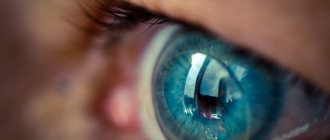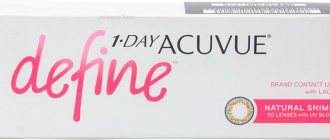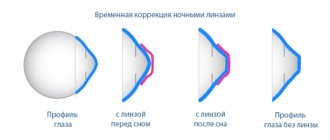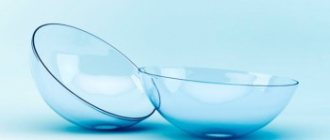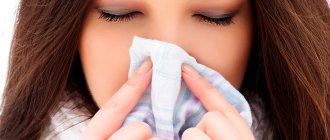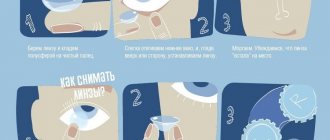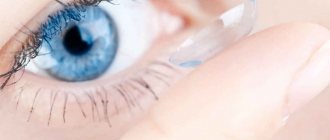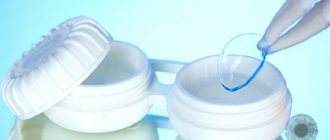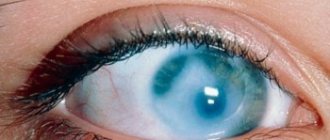Features of hydrogel lenses
Optical products based on hydrogel are in great demand due to their composition and lack of discomfort even during long-term wear.
Compound
To manufacture the presented models, hydrogel polymers (special gel and water) are used. These materials provide comfortable wearing as they are compatible with ocular tissues.
Thanks to innovative technologies, it has become possible to use not only one polymer in manufacturing, but also to combine it with others. You can also include a number of auxiliary components in the composition, including hyaluronic acid. It promotes eye hydration and comfort.
Polymers perfectly absorb moisture, which improves their oxygen permeability and gives the material flexibility.
What does moisture content mean in contact lenses?
The humidity level is measured in %. Without moisture, it is impossible to keep your eyes healthy when wearing contact lenses. If a person has dry eye syndrome, then optical products with a high level of moisture content have healing properties.
Some experts believe that the higher the moisture content, the better. But this opinion is erroneous, since everything depends on the material that was used in the production process. If we talk about hydrogel lenses, then the moisture in them serves to ensure oxygen exchange with the cornea. Thus, wearing the products will be comfortable.
The higher the moisture concentration, the faster they will dry the eyes, because the product will work like a “sponge”, absorbing all the liquid from the eye shells. Therefore, when choosing, you should pay attention to those in which the moisture content is below 50%.
How many hours can you wear
Due to their low moisture content, the lenses are suitable for long-term use. You are allowed to wear the product for a month without taking it off. But here you need to consult an ophthalmologist.
To avoid unpleasant sensations, you should take them off at night, and wearing them should not exceed 10-12 hours.
How do hydrogels differ from others?
As already described above, it is based on hydrogel polymers, which are characterized by excellent compatibility with the tissues of the organ of vision. These lenses are presented in the form of a kind of polymer frame with water. They absorb moisture, forming water channels through which oxygen flows to the cornea. And the high concentration of water ensures comfortable wearing. But some patients note the development of unpleasant sensations during use in rooms with insufficient humidity or after prolonged exposure to the monitor.
Hydrogel models also have certain disadvantages, one of which is the evaporation of vaginal fluid. This can cause redness and burning in the eyes. The level of oxygen permeability of these products is 40 Dk/t, and ophthalmologists recommend choosing models with 80 Dk/t. Because of this, doctors advise wearing them no longer than 8-10 hours a day, and taking them off before going to bed.
Another difference is the softness of the products. Thus, they do not hold their original shape well, which means they are very easy to damage. You can find out more about how to choose lenses here.
What is the DCL level and moisture content in the polymer
These two characteristics are very important when choosing a model for use. It is necessary to explain what they mean.
Our cornea receives oxygen from the tear fluid, which wets it during blinking, as well as from the surrounding air. Lenses on the eyes are a foreign body that prevents the normal supply of oxygen from the external environment. This is why it is important that their material has high oxygen permeability. This characteristic is designated as DCL, DCT or Dk/t.
The higher this indicator, the better the polymer transmits oxygen.
The moisture content level shows how much water as a percentage is in the material. Without a sufficient amount of it, comfortable operation of the optics is also impossible. It is important to choose the optimal ratio of moisture content and DCT level so that the model is suitable for constant wear.
Review of the best brands and manufacturers
You can purchase only after consulting an ophthalmologist, who will individually recommend a specific model and manufacturer.
Acuvue
These products are characterized by high oxygen permeability - from 25.5 Dk/t. In addition, the advantages are comfortable wear and a high-quality ultraviolet filter. Moisture content not lower than 58%. This is a good indicator that will ensure comfortable wear throughout the day.
When choosing this manufacturer, you should pay attention to one-day 1-Day Acuvue Moist with 25.5 Dk/t. This model is characterized by a sphere run-up from -12 to +6. There are also products for people with astigmatism. Find out about the benefits of two-week Oasis Acuview lenses here.
The cost is from 1050 rubles.
Bausch Lomb
This company has been supplying the market with various lens options for a long time, including hydrogel ones. Their product line is quite wide, so everyone can choose an option for all occasions. Among the entire assortment you can find one-day and three-month ones, as well as regular and colored ones.
Biotrue ONEday remains the most popular. This is a one-day option that has high quality and excellent characteristics. Oxygen permeability is 42 Dk/t, which ensures comfortable operation. However, the moisture content is 78%, so dry eye may occur. You can purchase products at a price starting from 1190 rubles.
In addition, a popular model is Bausch & Lomb SofLens Natural Colors New, which has 5 color options.
Dailies
This company produces optical products intended for one-day wear. The main advantage of the products is that they are reasonably priced and have a sufficient level of comfort while wearing them. Dailies produces exceptionally successful models for everyday use. For example, the AquaComfort PLUS model has an oxygen permeability of 26 Dk/t, and a high moisture content of 69%, which can cause discomfort for people with sensitive eyes. Find out about the features of Air Optix lenses in the article.
Product cost from 990 rubles.
CooperVision
This company produces interesting models that have quite high characteristics. The assortment includes not only “ephemeral” lenses, but also lenses designed for a month of wear.
The CooperVision Avaira model, which is suitable for monthly wear, is considered very popular. The moisture content is 46%, so such lenses will not dry out the membranes of the eye. Oxygen permeability is 125 Dk/t, which ensures a stable flow of beneficial components to the eye tissues. You can buy products at a price of 1100 rubles. Also learn about Pure Vision lenses in this material.
FreshLook
This company produces relatively cheap colored lenses based on hydrogel. All models have natural shades and excellent quality characteristics. Can be worn all day long. The main advantage of FreshLook is its naturalness, especially for people with brown eyes.
A popular model remains FreshLook ColorBlends - a universal option that looks great on dark, natural iris colors. The Freshlook color lens palette is presented here.
The cost from this manufacturer is from 790 rubles.
MATERIALS FOR CONTACT LENSES IN 2008
05.06.2017
Today, contact vision correction resembles a luxurious restaurant with many delicious dishes. The doctor offers a huge number of contact lenses (CLs) with different designs and made from different materials. The modern market for contact vision correction (CVC) is able to satisfy the needs of almost any patient. The reason is that in the last 10 years there has been a sharp increase in interest in CSC and research in this area. Manufacturers also kept up with the researchers. In fact, the latter were the direct customers or employers of the former. Almost all of the major companies consulted with polymer chemists or employed full-time research staff in their laboratories to constantly create innovative materials to improve the quality of lenses. The materials of modern CLs have an extremely complex chemical composition. Intricate combinations of polymers provide unique characteristics to each lens. However, no matter how complex, no matter how different the polymer structure of different lenses is, the manufacturer faces the same simple tasks: to make a stable, comfortable lens with excellent optical characteristics that would reduce or even eliminate the risk to eye health. Researchers continue to study the key chemical components of CL materials in the hope of obtaining optimal design, oxygen permeability, wettability, surface smoothness and resistance to various types of deposits in one bottle. Materials for soft contact lenses By definition, soft or, as they are sometimes called in English, hydrophilic lenses (SCL) are capable of absorbing and retaining water within a matrix consisting of polymer chains. This is what is usually called a hydrogel material. In many CLs, the main water-absorbing chemical monomer is hydroxyethyl methacrylate (HEMA). The presence of water in the CL matrix itself is associated with a number of both advantages and disadvantages. On the one hand, the water between the polymer chains of the material provides softness and flexibility to the lens, which gives users of hydrogel contact lenses greater comfort compared to rigid gas permeable lenses. Water also provides a mechanism for delivering oxygen to the corneal surface through its ability to dissolve and transport oxygen. On the other hand, water also weakens the strength of the lens, which is why it is often necessary to add ethylene glycol or other cross-linking agents to the matrix to strengthen the lens and ensure its structural stability. In addition, water is an excellent environment for the growth of bacteria, which means that in order to avoid bacterial contamination, it is necessary to strictly follow the wearing regime and the rules for caring for lenses. Trying to find a balance between the advantages and disadvantages of hydrogels and get the best option, manufacturers experimented a lot, changing the level of moisture content. The American Food and Drug Administration (FDA) has proposed its own classification of SCLs in accordance with the properties of the lens material, such as moisture content and electrostatic charge. Oxygen permeability The oxygen permeability of a CL depends on the Dk level of its material. Dk is defined as the diffusion coefficient (D) multiplied by the solubility coefficient (k). Thus, the Dk value reflects the chemical properties of the material itself. Of greater importance for clinical practice is the oxygen transmittance, or Dk/t, which expresses the properties of both the material and the design of the lens. Namely, oxygen permeability takes into account the thickness of the lens through which oxygen must pass to reach the surface of the cornea. By default, t means the thickness of the lens at the center. Because this thickness can vary significantly depending on the power of the lens, it is most common to measure Dk/t for lenses with a power of -3.00 D. As with lens thickness, there is large variation depending on the thickness profile - from center to edges of a particular lens. For example, at the periphery of a lens with minus power and a thicker edge, the oxygen permeability will undoubtedly be less than that measured in the center, where the lens is thinner. This is why research is still ongoing to develop better methods for determining the oxygen transmission capacity of certain lens designs. In traditional hydrogel lenses, oxygen permeability directly depends on their oxygen dissolution coefficient. The latter, in turn, is determined solely by moisture content. It would seem that in this case, one of the advantages of hydrogels should be a direct relationship between moisture content and oxygen permeability. All that remains is to increase the percentage of water in the lens, which should only have a positive effect on comfort. However, it quickly became clear that at the highest moisture content possible in practice, that is, about 80%, the maximum achievable oxygen permeability does not exceed 40 Dk. Having reached a dead end, scientists had to look for another way out in the form of more complex chemical compounds. As a result of these studies, silicone hydrogel appeared. This advance in materials chemistry resulted in the most significant breakthrough in the CSC industry's history. Silicone hydrogels are capable of both dissolving oxygen due to the hydrogel component of the matrix and transmitting it due to the silicone component. In modern spherical silicone hydrogel contact lenses (SGCL), the Dk value varies from 60 to 140 and, unlike traditional hydrogels, does not depend on moisture content. On the contrary, for most SGCL, an increase in oxygen permeability is associated with a decrease in moisture content, since it is based on an increase in the proportion of silicone in the matrix. As noted above, it is important to remember that for CLs it is not the oxygen permeability (Dk) itself that is important, but the actual oxygen transmission capacity taking into account the thickness of the lens (Dk/t). But, one way or another, when wearing a SGCL, significantly more oxygen reaches the cornea than when using any other types of SCL. Already at the very beginning of the “silicon hydrogel revolution”, many SGCLs had Dk values that even exceeded the minimum level of 87 for overnight wear, established in the famous work of Holden and Merz in 1984. Of course, thanks to the appearance of such lenses on the market, interest in 24-hour wearing has increased significantly. Many users have appreciated the convenience of flexible, extended or continuous monthly wearing patterns. But, unfortunately, studies have shown that the risk of microbial keratitis has not decreased with the appearance of FHKL, which means that the game is not worth the candle and for now it is better to play it safe. Elastic modulus With the advent of SGCL, such a characteristic of the lens as the elastic modulus of its material has again gained relevance. The higher the oxygen permeability, the more silicone should be in the material. But at the same time, the elastic modulus increases and the moisture content decreases, which seriously affects the initial comfort. Such a lens is constantly felt on the eye due to its rigidity and increased mobility. The rigidity of the SGCL and its constant interaction with the palpebral conjunctiva led to the same irritation and discomfort as when wearing rigid gas permeable contact lenses (GPC). Because of these negative effects when wearing SGCLs with ultra-high oxygen permeability and a high elastic modulus, two companies decided to create lenses with a lower silicone content. CIBA Vision released the O2Optix SCL and later the Air Optix Aqua (lotrafilcon B, Dk=110, 33% moisture content) as an alternative to the stiffer Focus Night&Day lenses (lotrafilcon A, Dk=140, 24% moisture content). CooperVision's low modulus Avaira SGCL (enfilcon A, Dk=100, 46% moisture content) actually has a lower moisture content compared to the Biofinity lens (comfilcon A, Dk=128, 48% moisture content). CooperVision explains this by saying that the reduction in modulus was achieved by using longer siloxane polymer chains, thereby reducing the proportion of silicone in the lens material. Wetness of lenses The inclusion of silicone molecules in the lens material has proven to be another challenge for manufacturers and developers, as it affects the overall wearing comfort. Silicone molecules are naturally hydrophobic, which makes it difficult for the lens to interact normally with both the tear film above it and the corneal epithelium below it. The water-repellent surface of the SCL led to disruption of the tear film, rapid dehydration of the lens on the eye, increased friction and decentration. All these factors led to complications such as dry eye syndrome, corneal staining, contact epitheliopathy of the eyelids, giant papillary conjunctivitis, constant sensation of the lens on the eye, and overall poor tolerance of CZ. So, a new task has emerged: to increase the biocompatibility of SGCL. Generally speaking, the hydrophilicity of CL in practice is associated with its ability to interact with the tear film and retain it over the entire (ideally) contact surface. Water has a fairly high surface tension. The higher the adhesive strength of a given material with water, the better it will resist surface tension, the better it will attract and hold water molecules to coat the surface of the lens. In clinical studies, wettability is determined by how the CL surface interacts with water. To do this, the angle formed between the drop and the surface is measured. CL with high hydrophilicity will attract water, and it will spread over the surface, forming a low contact angle (ideally equal to zero); CL with low hydrophilicity will repel water, which will eventually form many droplets on the surface at a large contact angle greater than or equal to 90 degrees. So, a new task has arisen for SGCL manufacturers: to make the initially hydrophobic silicone surface of the lens hydrophilic, attracting and retaining the tear film with the smallest contact angle, without compromising its integrity. The first SGCLs on the market, PureVision by Bausch & Lomb (balafilcon A, Dk=101, moisture content 36%) and Night&Day by CIBA Vision (lotrafilcon A, Dk=140, moisture content 24%) solved this problem using a special surface treatment. CIBA Vision applied plasma treatment, which resulted in the formation of a new, hydrophilic and electrically neutral surface, which allowed the lens to be classified as FDA Group 1. Bausch & Lomb's patented Performa technology involved the use of additional wetting agents that became part of the matrix so that the coating would not wear off during wear or mechanical cleaning. An electrical charge remained on the surface, so according to the FDA classification the lens belonged to group 3. In some GLCLs that came to market later, the wetting agent was directly incorporated into the polymer matrix at the very beginning of the polymer process, before the lenses were molded. For the production of SGCL Acuvue Advance (galyfilcon A, Dk=60, moisture content 47%) and Acuvue Oasys (senofilcon A, Dk=103, moisture content 38%) a similar Hydraclear technology is used, polyvinylpyrrolidone (PVP) is used as a wetting agent. As an alternative, we can mention Biofinity and Avaira SGCLs from CooperVision. In this case, proprietary Aquaform technology is used, based on the formation of hydrogen bonds on the surface of the polymer. As a result, comfilcon A and enfilcon A become hydrophilic and no wetting agents or surface treatments are required. Regardless of the humidification method used, quite effective mechanisms were obtained that balance the fundamental disadvantages of SGCL associated with the properties of the new material. Thanks to all these proprietary tricks, patients are provided with increased comfort. The availability of SGCLs in a wide variety of options, including toric and multifocal designs, allows more and more people to try “breathable” lenses. The problem of lens hydration is directly related to dry eye syndrome. Since dryness and discomfort caused by wearing CLs remain the leading cause of intolerance and refusal of CLs, manufacturers are making every effort to improve the characteristics of CL materials and solutions. At the same time, not only silicone hydrogel materials are updated, but also traditional hydrogel ones. In the minds of doctors, SCLs made from materials with high moisture content are consistently associated with such phenomena as rapid dehydration of the lens on the eye and symptoms of dryness. Not surprisingly, some companies have tried to avoid this pitfall and have released unique SCLs made from FDA Group 2 and 4 materials. For example, CooperVision has introduced phosphorylcholine into the polymer of the Proclear lens, as well as other SCLs made from omafilcon A material (62% moisture content). Phosphorylcholine is a structural component of the phospholipid bilayer of cell membranes in humans. The addition of an agent that has the same properties as corneal and palpebral epithelial tissues certainly significantly increased the biocompatibility of the lenses. As a result, the FDA has officially recommended Proclear SCLs for users who suffer from dryness symptoms and require increased comfort. CooperVision recently used phosphorylcholine in a 60% moisture version of omafilcon A and introduced the Proclear 1 Day lens as a result of this experiment. Manufacturers of other one-day CLs with high moisture content also strive to reduce the symptoms of dryness or get rid of them altogether. CIBA Vision uses polyvinyl alcohol (PVA) added to a polymer matrix in Focus Dailies with AquaRelease (nelfilcon A, moisture content 69%) SCLs. Under the mechanical action of the eyelid during blinking, PVA is gradually released from the lens, moisturizing its surface and maintaining the integrity of the tear film. CIBA Vision's newest advancement in this lens category is the Dailies AquaComfort Plus (nelfilcon A, 69% moisture content). Here, in addition to PVP, hydroxypropyl methylcellulose (HPMC) is used as a lubricant and polyethylene glycol (PEG) as an additional wetting agent. Thus, three moisturizing agents at once provide the best comfort throughout the whole day. Vistakon's 1-Day Acuvue Moist (etafilcon A, moisture content 58%) uses Lacreon's patented proprietary technology - the introduction of a hydrophilic polymer into the matrix to reduce friction and constantly maintain moisture on the lens surface. Surface friction plays an important role in SCC. Friction occurs during any mechanical interaction between adjacent surfaces, in this case the eyelid, lens and cornea. Of course, a wet lens surface reduces friction. It decreases even more in the presence of lubricant. This implies the importance of the tear film: if it covers the entire surface of the lens in a continuous and even layer, it significantly reduces the friction between the lens and the palpebral conjunctiva during blinking. Regardless of the presence or absence of lubrication, each surface has its own coefficient of friction. An example of a hard surface with very low friction is a Teflon frying pan. However, Teflon does not wet well, which suggests the role of other factors influencing hydrophilicity. The Teflon surface has its own electrostatic charge, which weakens its interaction with other adjacent surfaces. You don't have to look far for a similar example in the KKZ: the surface of the corneal epithelium with its relatively uneven glycocalyx reduces friction during blinking in exactly the same way - due to ionic elements. Materials for ZhGKL Almost all modern ZhGKL are made on the basis of methyl methacrylate (MMA), which ensures strength and retention of the shape specified during the manufacture of the lens. Unlike hydrogel MCLs, MMA polymers are hydrophobic and cannot absorb water. That's why the first polymethyl methacrylate (PMMA) lenses were called “hard” because of the hard, dense material. The PMMA lens material itself was not gas permeable, but their smaller diameter and design allowed oxygen to reach the cornea through a tear pump mechanism, which was much more efficient when wearing a GCL than when wearing an SCL. In modern JGCLs, as in SCLs, silicone is added to the MMA polymer to increase oxygen permeability. It was with the invention of silicone acrylate (SA) that the first “gas-permeable” CLs in the full sense of the word appeared, providing oxygen access directly through the lens material. Although silicone increases Dk, it also increases the hydrophobicity of the lens, which reduces surface wettability and increases lipid deposition. SA GLCLs remain the most common today, but fluorine molecules are also included in the matrix of many modern lenses - both to increase gas permeability and to improve wettability, surface integrity, and resistance to deposits. The low coefficient of friction and low surface tension of fluorine-containing polymers helps prevent deposits from sticking to the lens surface. Thanks to the high dk, fliconacrylate lenses (FSA) are the majority in the ZVGKL market recommended for an expanded wearing regimen. PMMA provides strength, constancy of shape and high transparency of the ZhGKL. Various crosslinkers bind polymer chains and increase the strength of the material. To improve humidity in the GSGK material, metacrilic acid (MA), N-vinylpyrrolidon (NVP), polyvinyl alcohol (PVA) or even Hema are included. At the same time, it is necessary to observe the balance: too small a moisturizing agent will not give the desired effect, too much will make the lens soft. To measure the maintenance or angle of wetting the GGK, various tests of in vitro are used, but with their help it is still impossible to predict for sure how stable the layer of tear film on the surface of the lens in vivo will be. In the United States, most of the companies producing materials for ZhGKL produces them in the form of blanks and sends them to independent laboratories for the manufacture and sale of lenses on order. These laboratories usually use their name as a trading brand. For a doctor, it is important to know the characteristics of each material, including an affordable choice of color shades. MKL has a surface, the ZhGKL has all the material of the lens. It is generally accepted that the rigidity of the ZhGKL is the cause of initial discomfort, the sensation of the lens in the eye and an increase in the time of adaptation. But this rigidity gives lenses a huge advantage: high quality optics. A strong optical surface of the ZhGKL provides high visual acuity even to patients with an incorrect shape of the cornea, in particular, with keratoconus, dystrophy and degeneration of the cornea. Thanks to the strength of the BSKL material, you can produce lenses of different design. Modern computer control machines allow you to pull out a complex design of complex design - with a posterior thorce, bitoric, simultaneous and alternating multifocals, with reverse geometry, orthocuratological and many others. Therefore, ZhGKL is often the best and even the only choice for a particular patient who needs the most accurate visual correction. One of the most important breakthroughs in the development of materials was the appearance of hybrid lenses with a hydrogel edge. At the same time, all optical advantages of the ZhGKL are preserved, but the initial comfort and a short period of adaptation inherent in MKL are added to them. The rigid part, made of newer materials with a high DK, retains all the advantages of the ZhGKL, which makes the market of hybrid lenses very promising. For example, the USA is officially approved by the use of Synergeyes Linz for Daily Wearing during myopia and hyperopia, presbyopia (Synergeyes Multifocal), keratoconus (Synergeyes KC), after injuries and operations (Synergeyes PS). The central zone is made of PAFLUFOCON D with a moisture content of less than 1% and DK = 100; The soft edge consists of a poly-hema (Liberfilcon) with a moisture content of 32% and DK = 8. ZhGKL successfully cope with many problems characteristic of MKL. Throughout the day, they retain a smooth, moisturized surface, which provides comfort and high quality of vision with minimal effects on the cornea. Like MKL, many ZhGKL undergo plasma processing to improve surface properties. For this, the manufactured lenses are placed in a reactive camera. In the process of processing, the surface of the lens is smoothed out, the last production waste is removed from it. It is not entirely clear how long the results of plasma processing of the ZhGKL are preserved, how important its effect is for patients with dry eye syndrome. However, experience shows that such processing really makes the surface of the lens clean and smooth, resistant to deposits. Some chemical properties of new materials for CL may seem too complicated and confusing. But it is the continuous development of science and industry that allows us to provide patients with more and more convenient, reliable and comfortable KKZ means. And therefore, each contact scientist must have at least a basic idea of the properties of materials in order to explain to the patient the advantages of certain types and specific brands CL.
Source: Glaz magazine, No. 1-2009
Solutions and protein cleaner for such lenses
Hydrogel lenses require regular care. In this case, special solutions will come to the rescue. They effectively remove protein deposits that are typical for the products in question. Lipid deposits form on soft ones and solutions that are not intended for such models will be ineffective. And their use can lead to staining of the cornea. In this case, you should stop using the product and choose more modern medications for care.
The following products are effective:
- Cleaners containing alcohol (must be marked “AOFlow”, “MiraFlow”), in combination with multifunctional solutions.
- Peroxide systems for cleaning and disinfection – One Step, Aosept plus.
- Multifunctional solutions that provide additional moisturizing during mechanical cleaning and washing - OptiFree Replenish, OptiFree Pure Moist, OptiFree Express, Biotrue, Synergi, Renu MPS and Renu Multiplus, Likontin Neo, Likontin Neo Multi, Likosol 2000.
Indicators of moisture content and oxygen permeability
Directly affect the comfort of use. Often, when deciding which brand to choose contact lenses, patients pay attention to them, because... Manufacturers in their descriptions focus on the convenience and “imperceptibility” of the model to the eye.
The parameters are closely related to each other and are determined by the material from which the correction products are made. Manufacturers use patented polymers, enrich them with moisture-retaining components and work on the gas permeability of the surface so that more oxygen reaches the cornea.
Most often, correction products are made from hydrogel and silicone hydrogel. The first polymer is saturated with moisture, but oxygen is less permeable. To make the gas permeability (Dk/t) higher, the lenses are made thinner, but it is difficult to maximize the parameter. Therefore, hydrogel models are not recommended to be worn continuously.
Silicone hydrogel has a “breathable” structure, and its gas permeability is higher. To solve the problem of low moisture content, manufacturers introduce humidifiers into the composition and increase the parameter to 55% and higher. These lenses are the modern “gold standard”, but in any case, the final decision always remains with the doctor and the patient.
Results
- Lenses based on hydrogel polymers are comfortable to wear and compatible with the eyes.
- They are easy to maintain as they accumulate minimal deposits. You just need to choose the right cleaner and follow the basic wearing rules.
- A wide selection of models will allow everyone to choose the ideal option regarding quality and cost.
- They have UV protection, are elastic and hypoallergenic.
- Very fragile, so they need to be handled with care.
- Due to the tight fit to the cornea, prolonged wear can lead to hypoxia.
Which lenses are more comfortable to wear?
Hydrogel lenses are softer and, when put on, are practically not felt on the eyes. However, during the day, the moisture evaporates, and they become harder, decrease in size, and begin to feel like a foreign body (this disadvantage causes practically no discomfort if you purchase the latest generation lenses with protection against dehydration).
Silicone hydrogel lenses have a higher elastic modulus and are therefore stiffer. But they do not cause discomfort throughout the day and, most importantly, provide a good flow of oxygen. It is possible to avoid corneal hypoxia. Unlike hydrogel lenses, with such lenses there will be no feeling of “sand in the eyes” even at the end of the day.
Cons of PremiO contact lenses (Premio):
- Lens Diameter (DIA)
— 14.0Thickness at the center of the lens
— 0,08
Moisture content
— 40%
DKL, Dk/t (Oxygen permeability)
— 161
Design
- spherical
Lens curvature (BC)
— 8.6, 8.3
Optical Power / Dioptres (D)
— from -0.5 to -6.0 (step 0.25), from -6.0 to -13.0 (step 0.5); from +0.5 to +6.0 (step 0.5)
UV protection
- There is
Lens color
- transparent
Moisture content
The Beyond family lenses have a unique combination of high oxygen permeability x material) with a moisture content that reaches a record level of 60%. This fact in itself is quite unique, since high moisture content is characteristic of lenses made of hydrogel materials, and the presence of a silicone phase significantly reduces the possibility of the lens becoming saturated with water. For example, for Clariti 1 day lenses (CooperVision) with Dk/t = 86 units. moisture content is 56% (Fig. 2). It is curious that biocompatible daily lenses Proclear 1 Day (CooperVision) have an equally high moisture content (60%), but we should not forget that these lenses are made of omafilcon A material, which does not contain silicone at all. The same can be said about SofLens Daily Disposable hydrogel lenses (Bausch + Lomb) made from hilafilcon B material with a moisture content of 59%.
The combination of high oxygen transmission and moisture content comparable to that of hydrogel lenses in the Beyond family of lenses is made possible by the use of Aquagrip technology, which guarantees high levels of oxygen, ions and water transmission to the eye necessary to maintain healthy eyes. The oxygen transmittance of these lenses is significantly higher than the minimum recommended. Efficient ion transport ensures perfect lens glide and unsurpassed comfort for the lens wearer.
Lenses with high moisture content quickly dehydrate during wear. Although they provide high initial comfort, they quickly become uncomfortable during the day of wearing them. This rule applies to lenses that do not have biocompatible properties. The biocompatible material of Beyond 1-day lenses guarantees their resistance to dehydration and ensures minimal moisture loss during the entire time of use. In addition, biocompatible lenses are highly resistant to deposits, which also contributes to long-term user comfort and consistently excellent visual acuity.
Rice. 2. Moisture content of Beyond 1-day lenses from Clearlab and soft contact lenses from other manufacturers: I – Beyond 1-day (Clearlab); II – Proclear 1 Day (CooperVision); III – SofLens Daily Disposable (Bausch + Lomb); IV – Clariti 1 day (CooperVision); V – MyDay (CooperVision)
Brands of silicone hydrogel contact lenses
According to the period of wearing and replacement, silicone hydrogel contact lenses come in the following brands:
Brands of daily silicone hydrogel lenses
- one-day wearing period – Acuvue TruEye, Acuvue Oasys 1 Day with Hydraluxe, Dailies Total 1
Brands of two-week silicone hydrogel lenses
- two-week wearing period – Acuvue Oasys, Acuvue Oasys for Astigmatism
Brands of monthly silicone hydrogel lenses
- monthly wearing period – Pure Vision, Pure Vision 2 HD, Air Optix Aqua, Air Optix Multifocal, Air Optix for Astigmatism, Air Optix Plus HudraGlade, Air Optix Night Day, Adria O2O2, Biofinity, Biofinity XR, Biofinity Toric, Biofinity Multifocal, Clariti Elite
Silicone hydrogel lenses are not produced for a wear period of more than a month.
